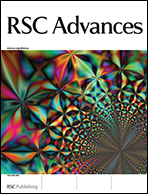A facile strategy for the synthesis of hierarchical CuO nanourchins and their application as non-enzymatic glucose sensors†
Abstract
We have demonstrated a facile strategy for synthesizing hierarchical CuO nanourchins (<300 nm) made from nanopetal building blocks by using a Cu2O-templated oxidative method. These hierarchical CuO nanourchins can serve as a promising electrode material and display an excellent response to


 Please wait while we load your content...
Please wait while we load your content...